Part II of Launch!
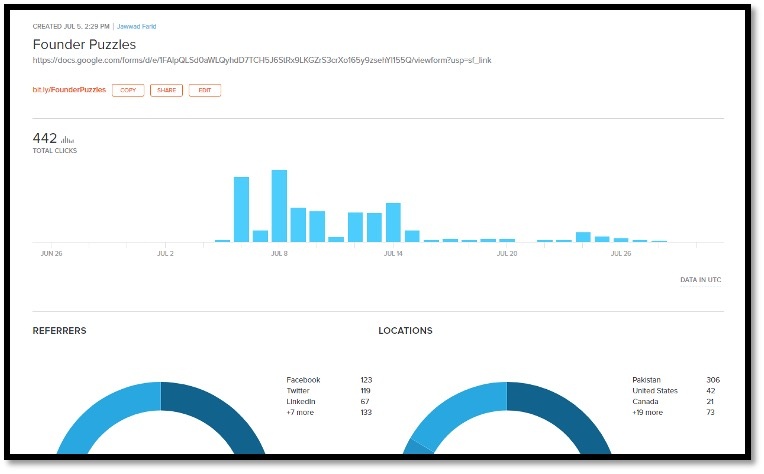
The test launch of Founder Puzzles, the book you hold in your hands serves as an interesting case. In July 2020, Founder Puzzles was released for a small test audience of desi founders using an organic reach only model. The launch model did not use paid promotions and relied entirely on organic reach generated through social platforms.
Internally within the team, it was a social experiment. We were trying to answer the question we had asked earlier in this chapter. If we put something on our combined social platforms, how many orders would we be able to generate? Our model predicted initial sales of 46 copies using the size of our social network. Could we do better?
Our primary objective was to assess interest in the book within the local market and get feedback from prospective readers. The text is designed to be a living book with short gaps between revised edition, each edition marginally better than the previous one. The test launch was designed to elicit feedback and set foundation for launch of revised edition a few months later. While you could still do a living book with print, the cycle needs to be longer. With e-books, it can be significantly shorter.
Why a test launch? The living book mindset asks a more fundamental question. How do you sell a million copies of your book?
You start by selling one hundred copies. Then sell another hundred. Rinse and repeat till you get to one thousand. Keep on repeating the cycle till you hit your goal.
How long do you think it will take you to get to your goal post at that rate? A long time for most authors.
Unfortunately, there are not short cuts, this is the only documented path for ordinary mortals. The exception being Michael Lewis who sold 350,000 copies of Flash boys in the first three weeks of being released.
Ryan Holiday brings this point out in Perennial Seller. Best-selling books take time to build and write, evolve, and grow over time. If you want to sell a million copies, you must have a book worthy of those sales and you must bring your long game to the table.
Even to sell a few hundred copies, there are qualifiers you must meet as an author. Check all of them before you decide to promote a book.
- You must have been writing for a while. Where while is greater than 10+ years.
- You must write well. People you don’t know must think so.
- Ideally have a platform of followers and credibility within your field.
- Credibility on a topic that audience want to read and are willing to spend money on.
- Material that helps or creates impact or value for your readers.
A traditionally published book sells less than 250 copies in the first year of its launch. A self-published e-book does less than one hundred copies in its first year. A professionally managed launch for a self-published e-book does a little better.
Our goals were set lower. In our primary market, readers still prefer print. They like to hold a book in their hands as they read it. Our expectation was that despite being interested a great many reader simply won’t buy the book because it is in electronic form. Beyond that for our first edition, we only had time for a PDF version. We couldn’t get an epub or mobi (kindle compatible) file ready in time for test launch.
Why not print?
Why not do a print edition? Wouldn’t more people buy it?
Bad memories and baggage from travelling this road a few times. Print is expensive. Print is slow. The breakeven point for a print edition is very different from a digital one. Print adds an additional layer of complexity, which is logistics. Beyond costs, you can’t do instant fulfillment for a global audience with print.
We had tried print with four earlier adventures. Despite respectable numbers, the math for print doesn’t even come close to digital. Our experiences also indicated a shift towards digital. While we loved getting our hands on a physical book, over the last year, most books we had read were digital.
Print wasn’t an option for us also because of the pandemic. Printing presses and publishers were classified as non-essential businesses and were closed throughout the duration of the lockdown. Print logistics were even more awkward since the primary paper market and commercial print quality paper imports were closed. While courier services were delivering mail and packages, delivery logistics were a new nightmare.
We certainly lost a few orders because we didn’t have a print edition. But we were able to do more with what we did have because we took the digital route.
Launch expectations
What did we expect to achieve from the test launch?
Can we get 100 pre orders for a digital edition priced between $19 to $29. For a local founder that is a steep price point for a PDF. A simple file with supporting Excel spreadsheets would generally not be perceived as sufficient value at this price point by customers. The price point also ruled out a Kindle or an iBook edition of the book. Given the audience profile we were looking for, these weren’t the right choices at launch stage.
The first big test was to get 100 pre-orders. We hit it in 4 days of launch of the pre-order page. A pre-order was just an email address, a payment preference indication and an answer to the simple question – how did you hear about this book?
Our next big goal was to convert pre-orders received into 100 paid orders. This goal was crossed off within 7 days of going live with the final book order page. Our third a goal was to get 9 favorable reviews from founders and readers within the desi community. This one took a little longer.
There were a couple of issues. Launch week coincided with Eid holidays in the MENA region. A requested preface didn’t come in time to be included with the launch. Because of the nationwide PUBG ban, AWS servers weren’t accessible on the day the book order page was supposed to go live. Our shopping cart was hosted on AWS. While as engineers we could still hack our way to our store catalog and turn the products on, our customers were not likely to be this persistent.
We had the reviews out on LinkedIn but no page to direct traffic to because our shopping cart provider was down. A client deadline slipped, and we had to switch gears during launch week. All marketing and momentum building activities came to a halt as we re-assigned to a critical client. That is the downside of not being completely dedicated to your book.
Yet the book was off to a promising start. 8 weeks later we had crossed 165 paid orders and US$ 3,700 in gross sales. Average price point $22.47. Launch price $29.99. Preorder price $19.99.
These are not great numbers for a North American or European launch. But they are very respectable numbers for a digital product launch focused on founders in our part of the world.
Our original model forecast before we started thinking about the launch at the start of the year. 45 copies at $14. We had beaten our internal estimates for books sold by 3.7 times and book revenue by 6 times.
All this, excluding future firm commitments for 20 orders in November and two conversations with promising partners for a few hundred copies in print.
How did we do that?
Launch timeline
Founder Puzzles the book had been in the works for 4 years. We have run a training business for over two decades now. Within that business, we run a financial modeling workshop for bankers and founders. The materials for the book grew out of those workshops.
Writing books that are easier to understand for broad audiences are harder to write. In December 2019 it seemed that book may ship next year. The original launch date was set for the Columbia Business School Class of ‘00 reunion in April 2020. Nothing like walking into your 20th reunion with a fresh off the press tome bearing your picture.
The book wasn’t ready by March 2020. Then Covid-19 killed all debate and the reunion was cancelled. The next available shipping slot was July. We would know by early June if the July deadline was doable.
As July became a likely possibility we sent in requests for reviews to influencers within our network. Prior book launches had taught us that reviews were critical, notoriously difficult to lock down and always late.
If we knew in June ’20 that the book would be ready by July, when did our prebuild for launch phase start? November 2019 at 021Disrupt in Karachi. How?
We knew the book would be ready in the next 12 months. Just didn’t know when. We also knew who the primary audience was going to be. Founders. Disrupt was great founder focused event to start thinking about the groundwork. We would rather be early than late with prebuild.
What did we do in the prebuild stage? It helps to map out the community and influencers right at start. It helps to start building relationships that didn’t exist before. Compared to LinkedIn and Facebook, Twitter was beginning to stand out. While LinkedIn groups was dying a sorry death, Twitter’s reach, community, and engagement had started to pull ahead.
Twitter threads were the first step. Here is a link to a partial selection that we posted during the prebuild phase http://bit.ly/Twitter-Threads

We did threads on starting up, unit economics, selling, pricing, endurance, and founder mindset. They were a great way of establishing a connection with founders across the local twitter verse. It helped that we were teaching a technology management course that overlapped with the theme of the book. Weekly lecture summaries and class notes made for engaging posts.
Our personal favorites were how to sell a million copies of a book, roadmap to launch, creating monsters, and the path to a million dollars in revenues. The content and copy was good enough to be turned into a post dedicated to the twitter threads at http://bit.ly/FTC-Twitter-Threads
The prebuild ran in intermittent mode till May of 2020 as we kept up with the threads and chapter extracts without mentioning the book. In June we stepped up our game. As we transitioned from prebuild to the awareness, excitement, and education phase there was a subtle shift in our tone compared to prebuild. Something was coming.
On 5th July we launched posts focused on back stories connected with shortlisted frames of images for the book cover. 9 frames, 9 stories. It was official. There was a book. It’s title, Founder Puzzles.
On 6th July, the second post in the series had the pre-order page embedded within it. It was posted the same day on Twitter and the first preorder came in within an hour of the pre-order page going live.
In addition to tracking inbound traffic using analytics, we used Bitly link shortener and tracking tool to track traffic. We asked in the pre-order form where buyers had heard about the book.
We used Google forms for taking down preorders after spending less than twenty minutes on setting the page up.
From a design point of view the page scored a failing grade (an F, no less). I have never had a good eye for colors, frames, or lines. I remember looking at the page and thinking why would anyone put their name down if this is what the preorder page looks like? From a functionality perspective it barely got the job done. With the book deadline looming and other client deliverables running late it was all we had time for.
Surprisingly during the launch phase, the conversion rate of the pre-order page came in at a respectable 33%. Compare this with the 20% conversion rate on designed book order page that was launched later in the month.
While the page was bare bones, the leads were all qualified leads.
The only people who clicked through were the ones who were interested in the topic. They came to the page to see what the book was about. If they liked what they saw and price was acceptable, they put their name down. Two factors would have improved conversions further. The book launch included only a PDF version. It was not available in print, nor as an epub, mobi or Kindle format file.
For a PDF, the $19.99 pre-order price and the $29.99 launch price were quite steep for the local market. A lower price and availability of other more compatible formats would have helped with conversions.
The price point debate went on for a while. The perfect price point was $9.99. It worked for Kindle Direct Publishing, it was affordable, it broadened our reach and it would make the book work for the Apple bookstore.
While it was easier to discount the book, in our experience once a book was pegged at a certain level, it was difficult to raise it to a higher price point. We already had plans of adding Excel templates and with the templates a number between $19.99 and $34.99 was viable. Pricey, but viable.
The book cover stories continued over the next few days. We did a cover reveal, a dedication reveal and an initial review. Threads on founder and startup related themes continued. As pre-orders started flowing in, we started sharing order statistics and traffic experience with our audience.

Treating the entire launch as a live case study and social experiment on the local ecosystem, sharing and reporting data as it came in is a well-respected launch move. Daniel Vassallo used this quite effectively as part of the launch of his information products in 2019 and 2020.
What should be the focus of our analysis and the data that we would share? We identified questions that we thought would be of interest to a broader audience. And to founders and other startups. Even if they didn’t buy the book at this stage, there was value in the data we were publishing.
From a local ecosystem perspective, there is limited neutral or independent data available on actual dollars conversions across networks, especially on cross network basis. Most data sets and case studies are vendor sponsored and don’t translate well for local founders. Hence the key themes for our analysis and commentary were local context and local customers.
- Which social network was better in terms of generating traffic?
- Which network converted better in terms of pre-orders?
- What did customers prefer to pay with? Cash or cards?
- How did our numbers stack with other e-book and information product launches?
The last question was an interesting one. While digital product launches are common for North American and Western European markets, no one was sure if a digital product focused on startups and founders would fly in our part of the world. There is very little hard data around e-book launches in Pakistan. Free materials and data yes, paid for, no.
We shared data around payment choices made by customers (IBFT versus Cards) and reach by network (Linkedin, Facebook, Twitter).
Were customers comfortable using cards online for digital products? They were.
From an organic reach and conversion perspective which platform was better? Twitter, Facebook, Linkedin, YouTube or Pinterest? Twitter ranked first on the lead generation and conversion front. Facebook got traffic faster to your pages. LinkedIn finished third, followed by YouTube and Pinterest.
On July 12th we put up the book teaser video on YouTube and started sharing it on social properties. Short focused videos also help with conversions and ranking. The video was embedded on all book related pages. At 8 minutes it was longer than recommended but served more as a book summary rather than just a short teaser.
On 24th July, Friday afternoon, the book order page went live. Emails were sent to customers who had placed pre-orders letting them know that the book was live, and they could place their orders online. As we continued to receive pre-order notifications, we realized all embedded links had to be changed to direct traffic to the new book page, rather than the three-week-old pre-order page.
Here is a snippet and link to the LinkedIn post announcing the book page going live. http://bit.ly/LinkedIn-BookLaunch
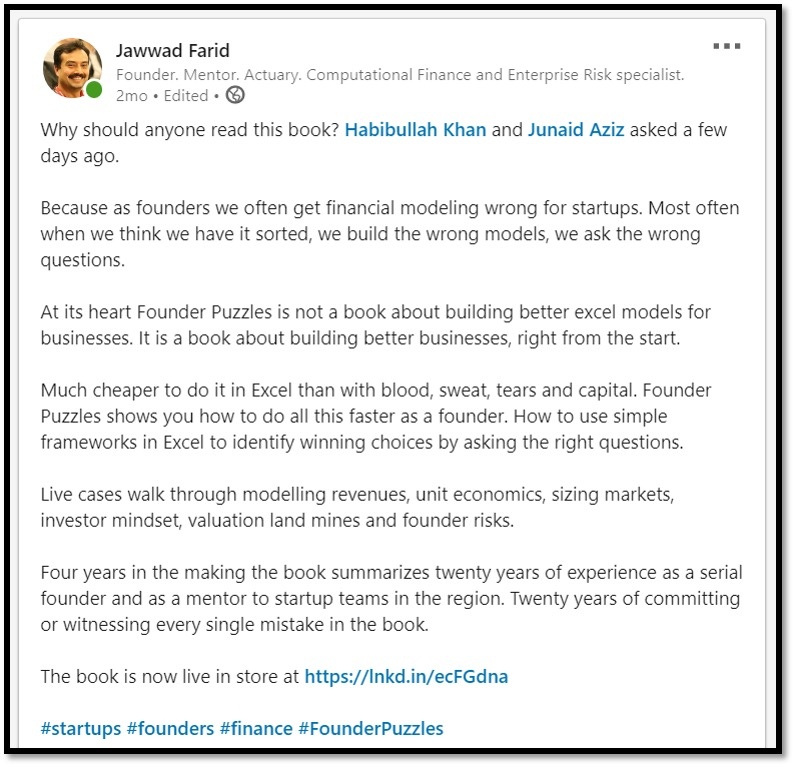
8 weeks later we sent a short thank you note to pre-orders that hadn’t converted. We thanked them for their support and let them know that they discount coupons for the pre-order price would expire by the end of the month. The follow up generated a small uptick in order over the next 8 days. Once again confirming sales were a function of your exposure half-life.
Founder Puzzles. The data set
Source and referral. Actual pre-orders compared to converted pre-orders by source and referral impressions. Impressions based on Twitter, LinkedIn, and FB data. FB impressions data is based on internal approximation. LinkedIn and Twitter based on actual impressions. Our social footprint at the time of launch stood at 7,000 LinkedIn followers, 2,000 friends and 9,000 fans on Facebook and 2,400 Twitter followers in April 2020.
The original pre-order link went live on 6th July 2020 at 10:30 am. It stopped processing pre-orders on 25th July 2020. In 18 days, we received 150 pre-orders for Founder Puzzles. Here is a snippet and link to the original twitter thread sharing the preorder link with the world. http://bit.ly/FP-Twitter-One

The book page where you could place the order, make a payment, and download a copy of the book went live on 24th July.
As of 29h September, two months later the page had processed 86 e-book orders for Founder Puzzles from the initial launch effort. An additional 42 copies were sold via our direct corporate sales program. 37 orders came directly through IBFT transfers. 165 orders in total.
Of the 150 pre-orders placed 97 converted into paid orders. In addition to 150 pre-orders, marketing threads for the book also generated 26 new orders – orders not linked or connected to original pre-orders. These new sales came in as reviews were posted and shared on Linkedin by other founders. Two of the big ones were Khurram Zafar (LUMS, NIC Lahore, 47 ventures) and Ahmed Khan (LUM, Savari, Daraaz and Cheetay) generated traffic as well as a spike in orders with their posts.
Of the non-preorder sales our estimate is the bulk of these leads came through LinkedIn, followed by Twitter, followed by YouTube. Facebook didn’t factor in this equation.
On the payment front, customers were given two choices. IBFT (online local bank transfers) or credit or debit cards. Of the 150 orders placed 83 customers opted for cards while 67 customers picked IBFT as their preferred payment option. IBFT customers were sent an email on the 24th morning. Credit card customers were sent an email with the book order page on the 24th evening.
The preorder follow-up email towards end September brought in 5 more orders from the original list, bumping up total conversion to 61%.
What proportion of pre-orders came from where? Based on customer answers on the pre-order form, the largest share of pre-orders came from Twitter and Facebook, followed by LinkedIn.
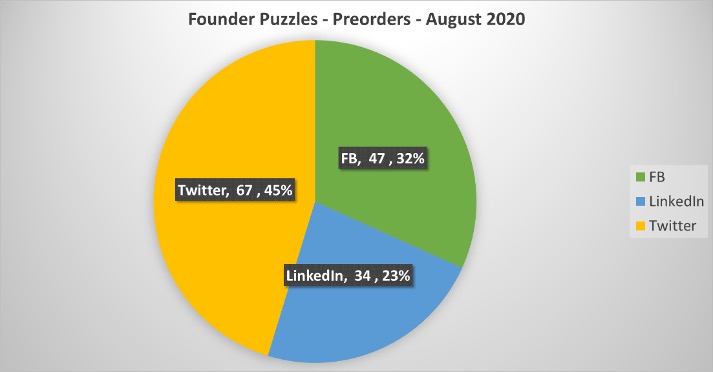
How did these orders convert to paid orders? In conversions to paid orders, Twitter clearly dominated the other two networks. While twitter and Facebook generated roughly the same amounts of clicks to the pre-order page, conversion of twitter leads into paid orders was far superior to the other two social networks.
Once the follow up email was sent to pre-orders that had not converted, the conversion rate improved slightly for all three networks. Sales also had a domino effect. As buyers commented on their purchase, people within their network also placed orders for the book.
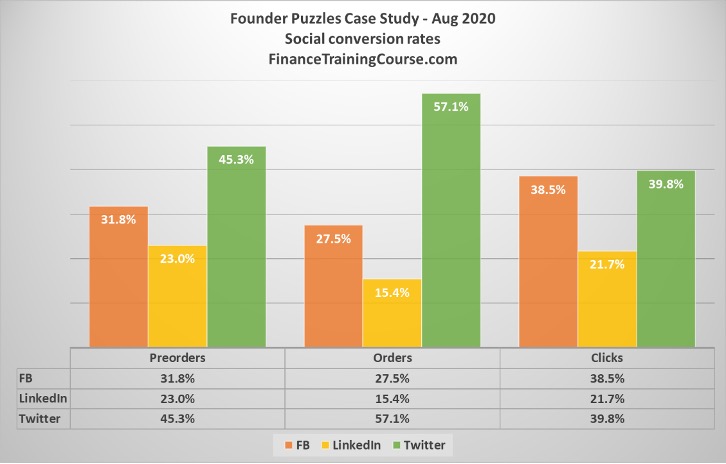
When we tracked pre-orders to paid orders conversion using pre-orders, Twitter converted at twice the rate of LinkedIn and 50% better than Facebook.
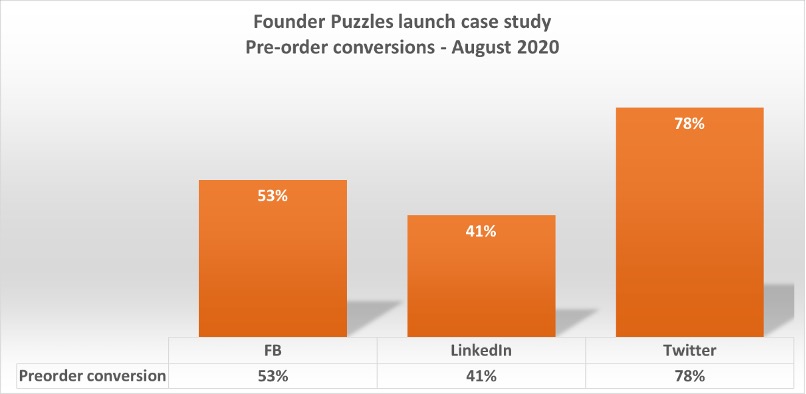
This was before the follow up email sent in mid-September
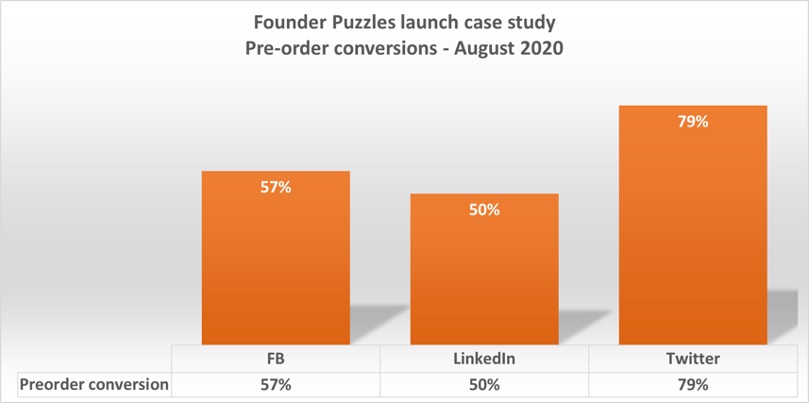
Total reach across all three platforms was 232,000 impressions. 232,000 impressions for USD 3,000 dollars in sales through 310 clicks, 150 pre-orders, 97 converted paid orders and an additional 70 orders not linked to the original campaign.
From a reach perspective this is an important metric. Twitter reach was over 100 times followers in our network because the content was relevant and engaging. LinkedIn reach was 4 times the size of network. Facebook reach was throttled at twice the size of the network despite some content posts doing well.
From a cost and value point of view the primary key words were startups and founders. As a key word “founders” is cheap, startups and financial modeling are expensive and difficult to rank under CPM and CPC models. At a crude $10 per CPM rate, the organic reach represented $2,320 in value on a CPM basis. 310 clicks at 30% conversion at $12 per click represented $3,700 in value on a CPC basis. This is the amount we would have spent to attract the same level of impressions and clicks using paid advertising on social platforms.
For reach and engagement to work, content needs to be fresh. Circulating stale content kills campaigns and networks.
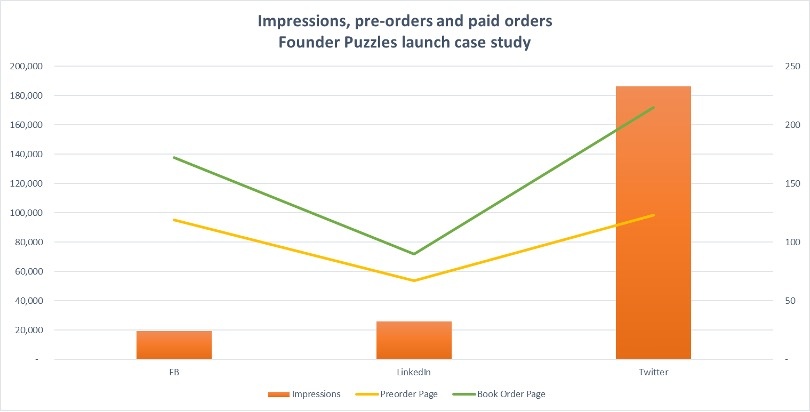
Why didn’t we try paid advertising?
Our shopping cart and landing pages were built using a popular shopping cart plug in which is notoriously slow. Directing paid traffic from social sites would end up with a larger than acceptable fraction of dropped clicks as landing pages took too long to load. We did try a short campaign with reddit and quit as soon as we realized the extent of our challenge.
In terms of impressions between LinkedIn and Twitter we were getting ample visibility for our target customer profile – desi founders. Since this was a test launch, the volume of impressions, traffic and orders was deemed sufficient.
Launch principles – takeaways
Your journeys are going to be different from ours. There is no cookie cutter approach or a perfect guide for launch. Even the framework we have presented above is just a starting point. Depending on the product you are selling and your target market the networks that worked for us, may not necessarily work for you.
Extend exposure across customers as much as you can. Not one and done but also not in your face. Fresh content drives engagement and keeps you visible on audience timelines. You want to be visible in a nice, soothing, flowers in a vase way. Pleasant enough for customers to give your ask the consideration it deserves. Not an annoying, needy buzz that demands muting.
Plan and secure fresh content ahead of your launch. That is one of the most difficult things on the list. Writing content that is relevant, engaging and converts is an art form and takes practice. It is difficult to get right and you won’t have time to create it on the fly.
What can we tell you?
The journey matters as much as the destination. Ups and downs, wins, disappointment, pivots, directional changes they are all part of the game. It is awkward, painful, heart breaking, sometimes rewarding. But you can only find how your movie ends if you start.
If you haven’t picked it up, here is the real lesson from this chapter.
There is no such thing as a single launch. There is a series.
You stop calling it launch after the first few are done. Then it becomes flow. A steady stream of orders and revenue. It is the stable steady state that we all want and aim for but only a few achieve. The guiding principle is the same as the one we have emphasized through out this chapter.
Exposure leads to traffic. Traffic leads to connection. Connection leads to conversion. Conversion leads to orders. Orders lead to dollars.
The best laid plans, time and effort spent in figuring out how to make things work takes you to a certain point. Once you open that door, step out and engage customers, everything is fair game.
Keep your ears open for one comment – “I don’t want this, but I would like to try that”. Sometime in our zeal to sell the version we are building, we forget to sell the version customers want.
Give your pre-order pages enough time to get traction. Easier to convert customers who have committed to a purchase than trying to find them cold turkey. Which means the pre-order page needs to go up as soon as you know the book will be ready for shipping. Not too early, but not too late.
Admittedly, our landing page didn’t ask for credit card information and didn’t ask you to buy the book. It just shared the book price point and said, we are taking pre-orders now and will let you know when it is ready to be shipped and we are ready to take orders.
With Founder Puzzles, the smartest thing we did was to roll out our crappy pre-order page. We hated it from day one. It was ugly but functional. It was the pre-order page that made the launch work. Two months after launch, it was also a source of secondary sales. A nicely worded email reminder sent to the pre-orders that hadn’t converted by then, resulted in an additional ten orders.
A pre-commitment rocks, even when it doesn’t convert. Making people wait, the anticipation for something to arrive, to be released from the wait, is part of selling the book. As an author that early stream of ten to fifteen orders on the first few days gives you a buzz you are going to remember for weeks to come.
Persistence. Persistence is highly underrated. There’s a difference between persistence and consistency. Consistency, under the right context, the right environment, and the right rules, is persistence. If you close your eyes, stick to your guns and refuse to change your mind, you are consistent. But when everything indicates that this is not going to work, evaluate the data and try a different tack. You get knocked down; you get up again. You are still in the game, but you are coming from a different path. Pivoting, learning, evolving, growing just so you can cross out another path that doesn’t work is persistence. Remember the difference.
Persistence also matters in building and sustaining momentum. It is difficult to rebuild lost momentum. We lost it all when a client crisis required our team to switch focus from the book to the fire, we had to put out elsewhere. Seven weeks later when we came back, we had to start all over again.
The final word. Reviews and testimonials. Book them in advance. Follow up on them. Be a pest till you get them. Post them. Share them. Publicize them. Reviews sell books. The more reviews you can attract, the higher the chance your book will be able to build on the momentum you have created for it. The same holds true for products.
References and additional reading
During our quest to sell a million copies of our book, a kind follower pointed us toward Daniel Vassallo (https://twitter.com/dvassallo) and his experience of selling $260,000 worth of digital products in less than a year. Daniel’s model focused on selling through twitter by building an audience and providing value to that audience.
While we had been slowly moving away from Facebook to Linkedin and Twitter, Daniel’s model was the final push that locked our launch strategy. While we would use whatever mileage, we could get from Facebook, the core effort of our book launch would focus on LinkedIn and Twitter audiences.
You can reach more about Daniel’s journey here.
Flash Boys, Micheal Lewis’ book on High Frequency Trading is a case study on how to piss the most people off quickly and make good money in the process. The book sold 350,000 copies in print with the first three weeks of launch. It represents a textbook case study of the one that got away.
For the record, Flash Boys was his 15th book. About 10 more books to go before we can attempt to even get close to replicating his feat.
On average number of copies a new book or author sells, see the next two articles. Typical first year sales between 150 – 250 copies. Lower for e-books. Still lower for international authors focusing on non-US or European markets.
https://outthinkgroup.com/the-10-awful-truths-about-book-publishing/
https://scribewriting.com/book-sales/
For average cost per thousand impressions (CPM) or cost per click (CPC) for Facebook ads in 2020 see
https://fitsmallbusiness.com/how-much-does-facebook-advertising-cost/

